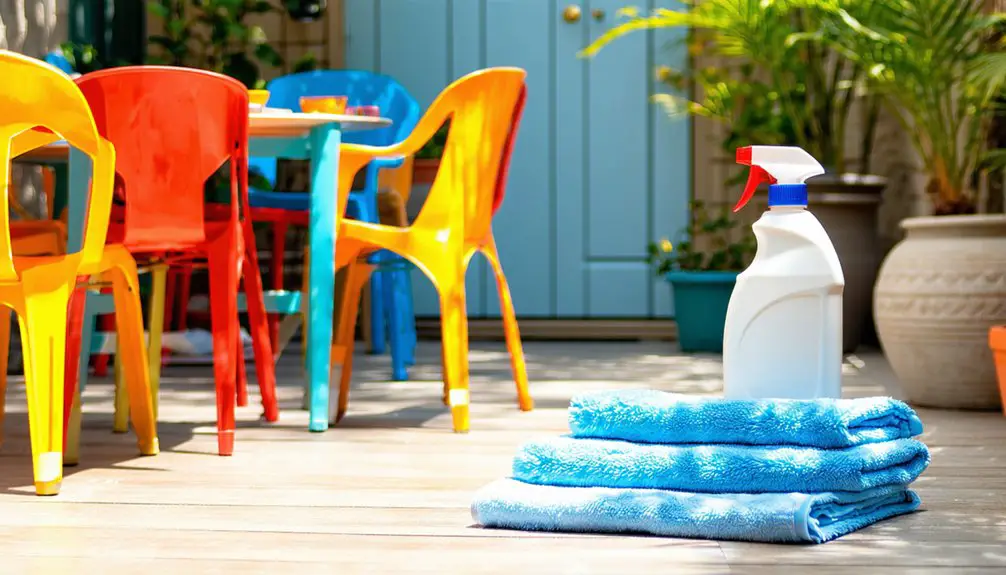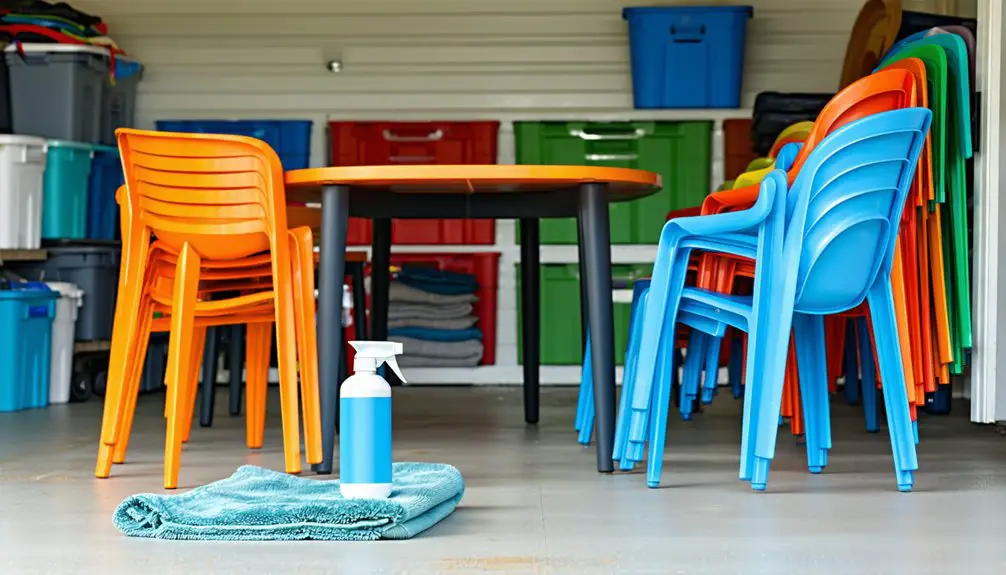To extend the life of your plastic furniture, start with a regular cleaning routine. Wipe them down every week with a damp microfiber cloth and do a deep clean monthly in high-traffic areas. Protect your furniture from the sun by applying an outdoor furniture protector or a UV-resistant coating. Keep an eye on hardware; tighten screws and clean them weekly to prevent wear. For storage, elevate items and use breathable covers. Regular inspections and timely repairs can also make a difference. If you want more tips on maintaining your furniture, stick around for additional insights!
Key Takeaways
- Clean furniture regularly using a damp microfiber cloth and natural solutions to prevent dirt buildup and maintain appearance.
- Apply outdoor furniture protectors and UV-resistant coatings to shield against sun damage and prolong lifespan.
- Inspect and maintain hardware monthly, tightening loose screws and replacing damaged parts with stainless steel options for durability.
- Store furniture in a well-ventilated area, using breathable covers and elevating items to prevent moisture and pest issues.
- Perform monthly deep cleans and regular inspections to identify and address wear or damage promptly for long-term maintenance.
Regular Cleaning Routine
To keep your plastic furniture looking its best, establish a regular cleaning routine. Aim to clean your furniture every 1-2 weeks to prevent dirt buildup and maintain its appearance. In high-usage areas, perform a deep clean monthly to combat wear and tear.
Daily, you can simply wipe down surfaces with a damp microfiber cloth to remove dust and debris.
For effective cleaning, mix equal parts white vinegar and water for a natural cleaning solution. Use this mixture along with a non-abrasive sponge or brush to tackle stubborn stains.
For routine cleaning, a solution of lukewarm water and dishwashing liquid works wonders. Remember to avoid harsh chemicals, like bleach, which can damage the plastic finish.
For special stains, you can use baking soda mixed with lukewarm water, letting it sit before scrubbing. Melamine foam sponges, like Mr. Clean Magic Eraser, are also great for removing marks without harming the surface. Additionally, regular cleaning will help you inspect for signs of wear after each session, ensuring your furniture remains durable.
Don't forget to schedule seasonal cleaning to prep your furniture for storage or harsh weather. Following these steps will help keep your plastic furniture in top shape for years to come.
Protection From Elements
While plastic furniture is durable, protecting it from the elements is essential for maintaining its longevity and appearance. To shield your furniture from sun damage, apply a coat of outdoor furniture protector. This helps prevent fading and cracking, keeping those vibrant colors intact. Additionally, homeowners are increasingly investing in their outdoor spaces, making it vital to ensure that outdoor furniture remains in top condition.
Consider using a UV-Resistant Clear Acrylic Coating after painting for added protection against harmful rays. Although plastic is typically waterproof, if you have non-recycled plastic furniture, applying a waterproofing spray can enhance moisture resistance. Make sure the design allows for proper drainage to prevent water accumulation, and regularly check for blockages in drainage points.
While corrosion and rust are generally not concerns for plastic, they can affect mixed-material sets with metal parts. For these, apply paste wax to create a barrier against corrosion. If you notice any rust, remove it before applying primer and paint.
To protect against physical damage, use a UV-Resistant Clear Acrylic Coating for scratches and wear. Additionally, paint the undersides of your furniture to guard against moisture and debris from the ground.
Regularly inspect your furniture for any damage and address it promptly to ensure its durability.
Hardware Maintenance

Maintaining your plastic furniture goes beyond protecting it from the elements; attention to hardware is vital for overall durability. Regular hardware inspection can help you catch problems early, ensuring your furniture remains sturdy and safe. Check for signs of wear or corrosion, and ensure all screws and bolts are tight and secure. Additionally, using recycled plastic materials in your furniture contributes to its long-lasting durability and resistance to environmental factors.
Regular cleaning with a mild soap solution can also help prevent damage to your furniture's hardware.
Here's a quick guide to hardware maintenance:
| Task | Frequency |
|---|---|
| Inspect hardware | Monthly |
| Tighten loose screws | As needed |
| Clean hardware | Weekly |
| Replace damaged hardware | Promptly |
When tightening hardware, use a screwdriver or drill driver, but be careful not to overtighten, as this can crack the plastic. Follow the manufacturer's instructions for specific tightening recommendations and always ensure good airflow around your furniture to prevent humidity buildup.
To prevent corrosion, keep your furniture clean and dry. Wipe it down regularly with mild dish soap and water, avoiding harsh chemicals. If you notice any corroded hardware, replace it promptly with stainless steel options to resist future damage.
Repair and Restoration
Repairing and restoring plastic furniture can breathe new life into your outdoor spaces, ensuring they remain functional and visually appealing.
Start by addressing broken parts; use authorized replacement components for a proper fit. For cracked or snapped molded brackets, secure them with screws. If you have larger breaks, epoxy putty like JB Weld can be effective—just ensure you hold the pieces together with a vise or C-clamps for 4 to 6 hours while it sets. Authorized replacement parts are recommended for optimal fit and durability.
To restore faded surfaces, gently sand the oxidized layer with soapy water and 150-220 grit sandpaper. Always sand in one direction to avoid scratches, and avoid using heat guns, as they can warp the plastic.
When bonding parts, opt for industrial-strength adhesives like E6000, as they're waterproof and flexible when dry. Apply the adhesive carefully to avoid waste, and always clean the surfaces beforehand.
Lastly, regularly inspect your furniture for signs of wear and follow the manufacturer's instructions to prevent future damage.
With these tips, your plastic furniture can continue to serve you beautifully for years to come.
Storage Practices

Proper storage practices are crucial for extending the life of your plastic furniture. Start by cleaning your pieces thoroughly to eliminate moisture, dust, and food particles. Use appropriate cleaning solutions and ensure everything is completely dry before storing to prevent moisture buildup. Additionally, it's important to elevate items off the floor to avoid contact with moisture and potential pests.
Here's a quick reference table for effective storage practices:
| Storage Tip | Description |
|---|---|
| Avoid Moisture | Don't wrap furniture in plastic; use breathable covers instead. |
| Protective Covering | Use old sheets or furniture bags to guard against dust and moisture. |
| Organized Arrangement | Disassemble larger items and store chairs upside down on tables. |
Make sure you lay down plastic sheeting on the floor for moisture protection without direct contact. Always keep your furniture in a well-ventilated area, and elevate it off the ground using pallets or boards. Remember to secure any doors or drawers with stretch wrap to avoid accidental openings. By following these practices, you'll help maintain the quality and longevity of your plastic furniture.
Frequently Asked Questions
How Can I Prevent Fading on My Plastic Furniture?
To prevent fading on your plastic furniture, apply UV protectants regularly, place it in shaded areas, and choose UV-resistant materials. Regular cleaning also helps maintain its appearance and extends its life.
What Is the Best Way to Remove Scratches From Plastic Surfaces?
To remove scratches from plastic surfaces, clean the area first, then use mild abrasives like toothpaste or sandpaper for deeper scratches. Finish by polishing the surface to restore its shine and appearance.
Can I Use Bleach to Clean Plastic Furniture?
You shouldn't use bleach to clean plastic furniture. It can weaken the material, cause discoloration, and make it brittle over time. Instead, opt for soapy water or vinegar and baking soda for safer cleaning alternatives.
Are There Specific Brands Known for Durable Plastic Furniture?
Yes, brands like Marmax, POLYWOOD, DUROGreen, and Breezesta are known for their durable plastic furniture. They use high-quality materials and advanced technologies to ensure your outdoor furniture withstands various weather conditions effectively.
How Does Plastic Furniture Compare to Wood in Longevity?
Plastic furniture generally lasts shorter than wood, often succumbing to UV damage and environmental factors. While it's durable for outdoor use, well-maintained wooden furniture can endure for generations, making it a superior long-term investment.

